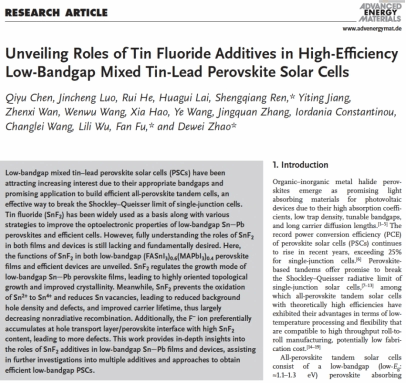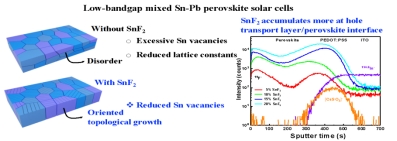In collaboration with Empa-Swiss Federal Laboratories for Materials Science and Technology, the Engineering Research Center of Alternative Energy Materials and Devices, College of Materials Science and Engineering(CMSE) has made headway in the research onlow-bandgap mixed tin-lead perovskite solar cells. Their research findings have been published inAdvanced Energy Materialsunder the title of“Unveiling Roles of Tin Fluoride Additives in High-Efficiency Low-Bandgap Mixed Tin-Lead Perovskite Solar Cells”. The first authors are Qiyu Chen, a Class 2018 graduate student, and Jincheng Luo, a Class 2020 graduate student. The corresponding authors are Shengqiang Ren, a full-time postdoctoral fellow, Dewei Zhao, a distinguished research fellow at CMSE and Dr. Fan Fu of Empa, Switzerland.


“Low-bandgap mixed tin–lead perovskite solar cells (PSCs) have been attracting increasing interest due to their appropriate bandgaps and promising application to build efficient all-perovskite tandem cells, an effective way to break the Shockley–Queisser limit of single-junction cells. Tin fluoride (SnF2) has been widely used as a basis along with various strategies to improve the optoelectronic properties of low-bandgap Sn-Pb perovskites and efficient cells. --- Here, the functions of SnF2 in both low-bandgap (FASnI3)0.6(MAPbI3)0.4 perovskite films and efficient devices are unveiled. SnF2 regulates the growth mode of low-bandgap Sn-Pb perovskite films, leading to highly oriented topological growth and improved crystallinity. Meanwhile, SnF2prevents the oxidation of Sn2+ to Sn4+ and reduces Sn vacancies, leading to reduced background hole density and defects, and improved carrier lifetime, thus largely decreasing nonradiative recombination. Additionally, the F− ion preferentially accumulates at hole transport layer/perovskite interface with high SnF2 content, leading to more defects. This work provides in-depth insights into the roles of SnF2 additives in low-bandgap Sn-Pb films and devices, assisting in further investigations into multiple additives and approaches to obtain efficient low-bandgap PSCs.” (Abstract)
This work was financially supported by the National Key Research and Development Program of China (No. 2019YFE0120000), the Fundamental Research Funds for the Central Universities (nos. YJ201955 and YJ201722), the Science and Technology Program of Sichuan Province (nos. 2020JDJQ0030, 2020YFH0079, and 2019ZDZX0015), the National Natural Science Foundation of China (nos. 62005188 and U1804132), Engineering Featured Team Fund of Sichuan University (2020SCUNG102), Natural Science Foundation of Jiangsu Province (BK20190825) and so on.
https://onlinelibrary.wiley.com/doi/10.1002/aenm.202101045
